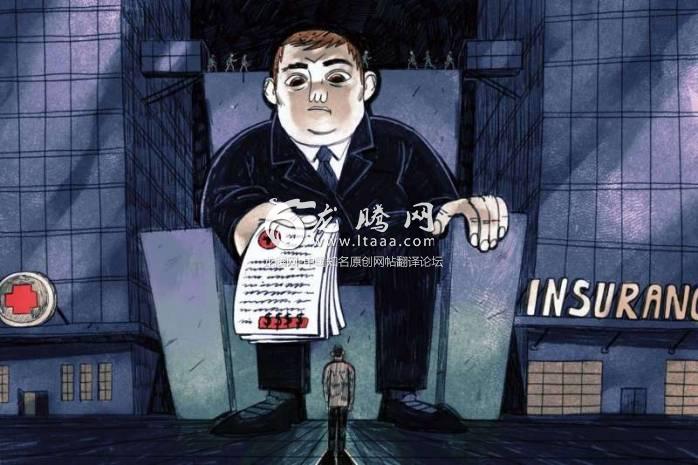为什么你的医疗保险公司不关心你的巨额账单(下篇) [美国媒体]
Frank越发地受挫,他利用自己几十年的经验,本质上成为他自己案件的专家证人。他收集了每一条相关信息以了解发生了什么,记录了Medicare(政府为残疾人和65岁以上的人提供的医疗保险计划)在NYU Langone部分髋关节置换的费用(约20491美元)......
Why Your Health Insurer Doesn’t Care About YourBig Bills
为什么你的医疗保险公司不关心你的巨额账单(下篇)
Increasingly frustrated, Frank drew on hisdecades of experience to essentially serve as an expert witness on his owncase. He gathered every piece of relevant information to understand whathappened, documenting what Medicare, the government’s insurance program for thedisabled and people over age 65, would have paid for a partial hip replacementat NYU Langone — about $20,491 — and what FAIR Health, a New York nonprofitthat publishes pricing benchmarks, estimated as the in-network price of theentire surgery, including the surgeon fees — $29,162.
Frank越发地受挫,他利用自己几十年的经验,本质上成为他自己案件的专家证人。他收集了每一条相关信息以了解发生了什么,记录了Medicare(政府为残疾人和65岁以上的人提供的医疗保险计划)在NYU Langone部分髋关节置换的费用(约20491美元),以及FAIR Health (发布的定价基准的纽约非营利组织公平健康) 估计为包括外科医生费用——29162美元的整个手术的网内价格。
He guesses he spent about 300 hours meticulouslydetailing his battle plan in two inches-thick binders with bills, medicalrecords and correspondence.
他估计花了大约300小时精心制定了其行动计划(两英寸厚的活页夹,里面有账单、病历和信件)。
ProPublica sent the Medicare and FAIR Healthestimates to Aetna and asked why they had paid so much more. The insurancecompany declined an interview and said in an emailed statement that it workswith hospitals, including NYU Langone, to negotiate the “best rates” formembers. The charges for Frank's procedure were correct given his coverage, thebilled services and the Aetna contract with NYU Langone, the insurer wrote.
ProPublica将Medicare和FAIR的医疗评估发送给Aetna,并询问他们为何多支付了这么多。该保险公司拒绝接受采访,并在一份电子邮件声明中表示,它与包括NYU Langone在内的医院合作,为会员协商“最佳费率”。保险公司写道,考虑到Frank的保险范围、收费服务以及Aetna与NYU Langone的合同,Frank的手术收费是正确的。
NYU Langonealso declined ProPublica’s interview request. The hospital said in an emailedstatement it billed Frank according to the contract Aetna had negotiated on hisbehalf. Aetna, it wrote, confirmed the bills were correct.
NYU Langone也拒绝了ProPublica的采访要求。医院在一份电子邮件声明中表示,它根据Aetna代表Frank谈判的合同向Frank开账单。它写道,Aetna证实账单是正确的。
After seven months, NYU Langone turned Frank’s$7,088 bill over to a debt collector, putting his credit rating at risk. “Theyupped the ante,” he said.
七个月后,NYU Langone将弗兰克7088美元的账单交给了收债人,这使他的信用评级面临风险。“他们提高了赌注,”他说
Frank sent a new flurry of letters to Aetna andto the debt collector and complained to the New York State Department ofFinancial Services, the insurance regulator, and to the New York State Officeof the Attorney General. He even posted his story on LinkedIn.
Frank疾风骤雨般的给Aetna和收债人发了一系列新的信件,并向纽约州金融服务局、保险监管机构和纽约州总检察长办公室提出申诉。他甚至在LinkedIn上公开了自己的故事。
But no one came to the rescue. A year after hegot the first bills, NYU Langone sued him for the unpaid sum. He would have toargue his case before a judge.
但没有人前来救援。在他收到第一笔账单一年后,NYU Langone因未付金额起诉他。他必须在法官面前为自己的案件辩护。
You’d think that health insurers would makemoney, in part, by reducing how much they spend.
你可能会仍未医疗保险公司赚钱,部分是因为减少了他们支付金额。
Turns out, insurers don’t have to decreasespending to make money. They just have to accurately predict how much thepeople they insure will cost. That way they can set premiums to cover thosecosts — adding about 20 percent for their administration and profit. If they’reright, they make money. If they’re wrong, they lose money. But, they aren’t tooworried if they guess wrong. They can usually cover losses by raising rates thefollowing year.
事实证明,保险公司不必为了赚钱而减少开支。他们只需要准确预测他们投保的人要花费的额度。这样,他们就可以为设定包括这些成本的保费——为他们的管理和利润增加大约20 %。如果他们是对的,他们会赚钱。如果他们错了,他们就会赔钱。但是,如果猜错的话,他们并不太担心。他们通常可以在下一年提高利率来弥补亏损。
Frank suspects he got dinged for costing Aetnatoo much with his surgery. The company raised the rates on his small grouppolicy — the plan just includes him and his partner — by 18.75 percent thefollowing year.
弗兰克怀疑他因手术让Aetna花费太多而被盯上了。公司在第二年将他的小团体政策—该计划仅包括他和他的合伙人—的利率提高了18.75 %。
The Affordable Care Act kept profit margins incheck by requiring companies to use at least 80 percent of the premiums formedical care. That’s good in theory but it actually contributes to risinghealth care costs. If the insurance company has accurately built high costsinto the premium, it can make more money. Here’s how: Let’s say administrativeexpenses eat up about 17 percent of each premium dollar and around 3 percent isprofit. Making a 3 percent profit is better if the company spends more.
平价医疗法案要求公司至少将80 %的保费用于医保,从而控制了利润率。这在理论上是好的,但实际上却促使了医疗成本上涨。如果保险公司把高成本准确地计入保费,就能赚更多的钱。下面如何达到的:假设管理费用花费了每笔保费的17 %左右,利润占3 %左右。如果公司花更多的钱,3 %的利润会更好。
It’s like if a mom told her son he could have 3percent of a bowl of ice cream. A clever child would say, “Make it a biggerbowl.”
这就好比妈妈告诉儿子,他可以吃一碗冰淇淋的百分之三。聪明的孩子会说:“用一个更大的碗。
Wonks call this a “perverse incentive.”
政策专家称这是“不正当的激励”
“These insurers and providers have a symbioticrelationship,” said Wendell Potter, who left a career as a public relationsexecutive in the insurance industry to become an author and patient advocate.“There’s not a great deal of incentive on the part of any players to bring thecosts down.”
Wendell Potter说:“这些保险公司和供应商有一种共生关系。”他辞去了保险行业公关主管的工作,成为一名作家和主张维护病人利益者。“任何从业人员都没有很大的动力来降低成本。"
Insurance companies may also accept high pricesbecause often they aren’t always the ones footing the bill. Nowadays about 60percent of the employer benefits are “self-funded.” That means the employerpays the bills. The insurers simply manage the benefits, processing claims andgiving employers access to their provider networks. These management deals areoften a large, and lucrative, part of a company’s business. Aetna, for example,insured 8 million people in 2017, but provided administrative services only toconsiderably more — 14 million.
保险公司也会接受高价,因为他们往往不是买单的人。如今,大约60 %的雇主福利是“自筹资金”。“这意味着雇主支付账单。保险公司只负责管理福利、处理索赔和让雇主进入他们的供应商网络。这些管理交易通常是公司业务中重要且有利可图的部分。例如,Aetna在2017年为800万人提供了保险,但为多得多的人仅提供行政服务——1400万人
To woo the self-funded plans, insurers need astrong network of medical providers. A brand-name system like NYU Langone candemand — and get — the highest payments, said Manuel Jimenez, a longtimenegotiator for insurers including Aetna. “They tend to be very aggressive intheir negotiations.”
为了争取自筹资金的计划,保险公司需要一个强大的医疗供应商网络。Aetna等保险公司的长期谈判代表Manuel Jimenez说,像NYU Langone这样的名牌系统可以要求——并获得——最高的报酬。“他们在谈判中往往非常咄咄逼人。"
On the flip side, insurers can dictate the termsto the smaller hospitals, Jimenez said. The little guys, “get the short end ofthe stick,” he said. That’s why they often merge with the bigger hospitalchains, he said, so they can also increase their rates.
另一方面,Jimenez说,保险公司可以将条款强加给较小的医院。小家伙们“把棍子的短端拿来”,他说。这就是为什么他们经常和更大的医院连锁合并,他说,他们因此也可以提高其费率。
Other types of horse-trading can also come intoplay, experts say. Insurance companies may agree to pay higher prices for someservices in exchange for lower rates on others.
专家说,也会发生其他类型的讨价还价。保险公司可能同意为某些服务支付更高的价格,以换取其他服务的更低费率。
Patients, of course, don’t know how thebehind-the-scenes haggling affects what they pay. By keeping costs and dealssecret, hospitals and insurers dodge questions about their profits, said Dr.John Freedman, a Massachusetts health care consultant. Cases like Frank’s“happen every day in every town across America. Only a few of them come up forscrutiny.”
病人当然不知道幕后的讨价还价是如何影响他们付款的。马萨诸塞州医保顾问John Freedman博士说道,医院和保险公司将成本和交易保密,从而规避了利润问题。像Frank这样的案例“在美国的每个城镇每天都在发生。他们中只有少数案例受到详细审查。"
In response, a Tennessee company is trying toexpose the prices and steer patients to the best deals. Healthcare Bluebookaims to save money for both employers who self-pay, and their workers. Bluebookused payment information from self-funded employers to build a searchableonline pricing database that shows the low-, medium- and high-priced facilitiesfor certain common procedures, like MRIs. The company, which launched in 2008,now has more than 4,500 companies paying for its services. Patients can get a$50 bonus for choosing the best deal.
对此,田纳西州一家公司正试图将价格公开,并向患者指明最好的交易。医保蓝皮书的目的是为自付工资的雇主和其工人省钱。蓝皮书利用来自自筹资金的雇主提供的支付信息,建立了可搜索的在线定价数据库,其公示了MRIs等某些常见程序的低价、中低价和高价设施。该公司成立于2008年,目前有4500多家公司为其服务付费。病人选择最好的交易可以得到50美元的奖金。
Bluebook doesn’t have price information forFrank’s operation — a partial hip replacement. But its price range in the NewYork City area for a full hip replacement is from $28,000 to $77,000, includingdoctor fees. Its “fair price” for these services tops out at about two-thirdsof what Aetna agreed to pay on Frank’s behalf.
蓝皮书没有弗兰克手术的价格信息——部分髋关节置换。但在纽约市地区的全髋关节置换价格从2.8万美元到7.7万美元不等,包括医生费用。这些服务的“公平价格”最高可达Aetna代表弗兰克同意支付的三分之二。
Frank, who worked with mainstream insurers,didn’t know about Bluebook. If he had used its data, he would have seen thatthere were facilities that were both high quality and offered a fair price nearhis home, including Holy Name Medical Center in Teaneck, New Jersey, andGreenwich Hospital in Connecticut. NYU Langone is one of Bluebook’shighest-priced, high-quality hospitals in the area for hip replacements. Otherson Bluebook’s pricey list include Montefiore New Rochelle Hospital in NewRochelle, New York, and Hospital for Special Surgery in Manhattan.
与主流保险公司合作的Frank不知道蓝皮书。如果他使用其数据,他会看到他家附近有高质量和价格公道的设备,包括新泽西州提颈的圣名医疗中心和康涅狄格州的格林威治医院。NYU Langone是蓝皮书公司在该地区价格最高、质量最好的髋关节置换医院之一。其他列入蓝皮书价格名单的医院包括纽约新罗谢尔的蒙特菲奥里新罗谢尔医院和曼哈顿的特种外科医院。
ProPublica contacted Hospital for SpecialSurgery to see if it would provide a price for a partial hip replacement for apatient with an Aetna small-group plan like Frank’s. The hospital declined,citing its confidentiality agreements with insurance companies.
ProPublica联系医院进行特殊手术,看其是否会为拥有像Frank那样的Aetna小团体计划的患者提供部分髋关节置换的价格。医院拒绝了,理由是它与保险公司签订了保密协议。
Frank arrived at the Manhattan courthouse onApril 2 wearing a suit and fidgeted in his seat while he waited for his hearingto begin. He had never been sued for anything, he said. He and his attorney,Gabriel Nugent, made quiet conversation while they waited for the judge.
Frank 4月2日穿着西装来到曼哈顿法院,坐在座位上坐立不安,等待听证会开始。他表示,他从未因任何事情被起诉。他和他的律师Gabriel Nugent在等候法官的时候进行了安静的交谈。
In the back of the courtroom, NYU Langone’sattorney, Anton Mikofsky, agreed to talk about the lawsuit. The case is simple,he said. “The guy doesn’t understand how to read a bill.”
在法庭的后面,纽约大学朗格尼的律师安东·米可夫斯基同意谈一谈这场诉讼。他说,案情很简单。“那家伙不懂怎么看账单。"
The highprice of the operation made sense because NYU Langone has to pay its staff,Mikofsky said. It also must battle with insurance companies who are trying tokeep costs down, he said. “Hospitals all over the country are struggling,” hesaid.
Mikofsky说,该手术的高昂价格是有道理的,因为NYU Langone必须支付员工的薪酬。他说,它还必须与试图降低成本的保险公司进行斗争。他说:“全国的医院都在苦苦挣扎。”
“Aetna reviewed it twice,” Mikofsky added.“Didn’t the operation go well? He should feel blessed.”
“Aetna审查了两次账单,” Mikofsky补充道。“手术不顺利吗?他应该感到幸福。"
When the hearing started, the judge gave eachside about a minute to make its case, then pushed them to settle.
开庭时,法官给双方大约一分钟的时间陈述案情,然后推动着他们和解。
Mikofsky told the judge Aetna found nothingwrong with the billing and had already taken care of most of the charges. Thehospital’s position was clear. Frank owed $7,088.
mikofsky告诉法官Aetna发现帐单没有问题,并且已经支付了大部分的费用。医院的立场很明确。弗兰克欠7,088美元。
Nugent argued that the charges had not beenjustified and Frank felt he owed about $1,500.
Nugent
辩称,该指控没有根据,Frank认为自己欠了大约1500美元。
The lawyers eventually agreed that Frank wouldpay $4,000 to settle the case.
律师们最终同意,弗兰克将支付4000美元来了结此案。
Frank said later that he felt compelled tosettle because going to trial and losing carried too many risks. He could havebeen hit with legal fees and interest. It would have also hurt his credit at atime he needs to take out college loans for his kids.
弗兰克后来说,他觉得自己被迫和解了,因为继续审判和失败有太多的风险。他可能会受损于律师费和利息。在他需要为孩子们申请大学贷款的时候,这也会损害他的信用。
After the hearing, Nugent said a technicalitymight have doomed their case. New York defendants routinely lose in court ifthey have not contested a bill in writing within 30 days, he said. Frank hadcontested the bill over the phone with NYU Langone, and in writing within 30days with Aetna. But he did not dispute it in writing to the hospital within 30days.
听证会后,Nugent说,技术层面的问题就注定了他们的案子。他说,在纽约如果被告在30天内没有以书面形式对账单提出异议,他们通常会在法庭上败诉。弗兰克在电话中向NYU Langone就该账单提出异议,并在30天内以书面形式向Aetna提出异议。但他没有在30天内向医院提出书面异议。
Frank paid the $4,000, but held on to hisoutrage. “The system,” he said, “is stacked against the consumer.”
弗兰克付了4000美元,但仍坚持其看法并十分愤怒。他说:“这种制度不利于消费者。"
版权声明
我们致力于传递世界各地老百姓最真实、最直接、最详尽的对中国的看法
【版权与免责声明】如发现内容存在版权问题,烦请提供相关信息发邮件,
我们将及时沟通与处理。本站内容除非来源注明五毛网,否则均为网友转载,涉及言论、版权与本站无关。
本文仅代表作者观点,不代表本站立场。
本文来自网络,如有侵权及时联系本网站。
图文文章RECOMMEND
热门文章HOT NEWS
-
1
Why do most people who have a positive view of China have been to ...
- 2
- 3
- 4
- 5
- 6
- 7
- 8
- 9
- 10
推荐文章HOT NEWS
-
1
Why do most people who have a positive view of China have been to ...
- 2
- 3
- 4
- 5
- 6
- 7
- 8
- 9
- 10











